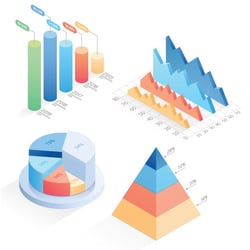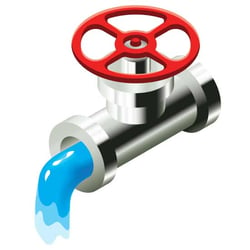 Every organization needs to decide which metrics they will track and measure. These metrics are indicators of your company's internal health, the performance of your products on the market, and the efficiency of your processes. Without tracking, measuring, and analyzing these figures, there is no definitive way to show success, find improvement opportunities, or learn from mistakes.
Every organization needs to decide which metrics they will track and measure. These metrics are indicators of your company's internal health, the performance of your products on the market, and the efficiency of your processes. Without tracking, measuring, and analyzing these figures, there is no definitive way to show success, find improvement opportunities, or learn from mistakes.
However, not all metrics apply to the same products. Furthermore, each development methodology will emphasize different metrics. Your executive management team needs to set the organizational metrics, along with the objectives and key results (OKRs) for the product portfolio. Your product managers need to know and define the key performance indicators (KPIs) that matter most and align with the bigger goals.
Adopting Agile Product Development
More and more companies are adopting agile product development processes, either across the entire organization or within their software development teams. To know whether your company is effectively following agile methods, your team must adopt, measure, and track key agile metrics.
Agile product development focuses on creating the best possible product for the target audience as efficiently as possible based on data and quick pivots. The main question to ask is whether or not you're creating value for the customer. For example, is the design valuable? Is the function valuable? Does each activity along the way add value either to the product or larger business goals? One of the best ways to gain knowledge on your products and systems is to set key metrics, measure them, and analyze the answers.
How Agile Methodologies Approach Metrics
Agile product teams need to make rapid decisions that are data-driven and current. To do so, they must have a system to quickly analyze the right metrics, producing a snapshot of the product. From there, managers can identify where changes need to happen.
Knowing what to measure to gain this knowledge is the vital first step. In SAFe Agile, the three overarching metrics used to inform companies of their progress are as follows:
- Outcomes - are we meeting the needs of our customers and our business goals?
- Flow - how efficient is our company at delivering value to our customers?
- Competency - how well are we following agile principles?
While these metrics may sound broad, they are scalable, meaning every team involved in product development can implement a version of them.
Agile Metric #1: Outcomes
 The basis of outcomes is whether or not an organization produces the desired results in delivering value to customers, growing the business, and keeping the workforce satisfied. Measuring outcomes is usually split into externally facing outcomes and internally facing outcomes. Measuring well on both of these metrics is a sign of a healthy organization.
The basis of outcomes is whether or not an organization produces the desired results in delivering value to customers, growing the business, and keeping the workforce satisfied. Measuring outcomes is usually split into externally facing outcomes and internally facing outcomes. Measuring well on both of these metrics is a sign of a healthy organization.
External Outcomes
Defining specific and measurable KPIs is the most common way to measure external outcomes. These should reflect the performance of your products and be relevant to the context in which your customers need your products. Not all businesses will benefit from tracking and measuring the same KPIs. For example, a SaaS company may want to track its customer retention rate, while a battery manufacturer will be more interested in units sold and cost per unit.
The following is a range of KPIs that different companies will want to track and measure, showing the diversity of options for various industries:
- Acquisition
- Revenue
- Retention
- Referrals
- Conversion funnel analytics
- Customer lifetime value
- Tickets outstanding
- First response time
- Cost per ticket
- Units sold
- Cost of goods sold
- Cycle time
Another external metric is the strategic themes set by your company. These OKRs define specific outcomes that mark future success for your business and are typically measured quarterly. OKRs can also be broken down to create relevant goals for each team level, especially in large organizations.
KPIs and OKRs serve your organization best when internal teams know about them, can see them, and contribute to the results. Tracking these metrics on your product roadmapping software helps inform your stakeholders with transparent, accessible data.
Internal Outcomes
Employee engagement is the primary indicator of internal outcomes. Studies show that teams who are highly motivated and actively engaged in the business are more likely to support the business goals and values. Higher engagement also leads to higher productivity, efficiency, and innovation.
How you measure employee engagement will depend on the structure of your organization and your management teams. Some companies rely on annual employee engagement surveys, while others will use an employee Net Promoter Score (eNPS). Whichever method you choose, the most important thing is to take action to encourage improvement based on the results of your evaluations.
Agile Metric #2: Flow
 Measuring flow is all about the efficiency of an organization in creating and delivering value to the customer. The original Flow Framework by Mik Kersten contains five metrics to measure and analyze. The SAFe Agile Framework adds an extra metric—Flow Predictability—to make the framework useful in agile product development. The six flow metrics used by SAFe Agile are as follows:
Measuring flow is all about the efficiency of an organization in creating and delivering value to the customer. The original Flow Framework by Mik Kersten contains five metrics to measure and analyze. The SAFe Agile Framework adds an extra metric—Flow Predictability—to make the framework useful in agile product development. The six flow metrics used by SAFe Agile are as follows:
- Flow Distribution - this measures the proportion of each type of backlog item in the flow.
- Flow Velocity - this is the number of items completed in a specific time.
- Flow Time - this is the time that elapses from when an item enters the workflow to when it is released to the customer.
- Flow Load - this is the total work-in-progress across all steps in flow.
- Flow Efficiency - this is the portion of time that backlog items are actively worked on compared to the total time elapsed.
- Flow Predictability - this is the overall planned vs. actual business value.
Companies can use integrative software to manage, track, and analyze these data points. For example, with product roadmap software, teams can track milestones, monitor timelines, and integrate with other software platforms to measure product backlog progress.
Agile Metric #3: Competency
 The SAFe Agile Framework also encourages measuring your organization's competency in pursuing agile methodologies. How proficient is your organization in agile practices? Setting a goal to implement agile methods won't lead to action without a plan in place and an assessment tool to gauge your progress.
The SAFe Agile Framework also encourages measuring your organization's competency in pursuing agile methodologies. How proficient is your organization in agile practices? Setting a goal to implement agile methods won't lead to action without a plan in place and an assessment tool to gauge your progress.
To support companies in their adoption of agile methods, SAFe created a Business Agility Assessment based on seven SAFe Core Competencies.
- Team and Technical Agility (TTA)
- Agile Product Delivery (APD)
- Enterprise Solution Delivery (ESD)
- Lean Portfolio Management (LPM)
- Lean-Agile Leadership (LAL)
- Organizational Agility (OA)
- Continuous Learning Culture (CLC)
Each of these measurements is both independent and interdependent. True implementation of agile methodologies requires an organization to excel in all seven areas. The company as a whole can use the Business Agility Assessment, and their teams can use the Safe Core Competency Assessment to evaluate the performance of each team or agile-release-train (ARTs) to see where improvements are needed. The goal is to keep the entire organization working together to better support the overarching goals.
Product Roadmap Software to Support Agile Businesses
Gocious Product Roadmap Management Software is a cloud-based software that features easy-to-use powerful roadmapping tools with clear visualizations your whole team can understand. Agile roadmaps allow all the stakeholders to recognize the goals, track the metric performance, and contribute to better product development. Try it out with a free demo to see how Gocious can work for your agile teams.


